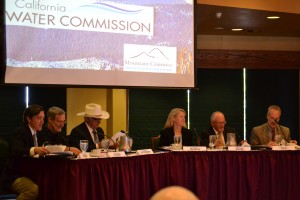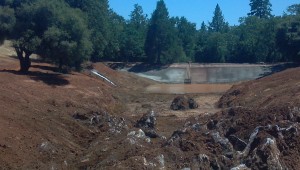By Roberta Long
MCWRA writer
Pictures from the Gallery
Three of California’s top water decision-makers came to Placerville on June 6 for a joint presentation by Mountain Counties Water Resources Association (Mountain Counties) and the Association of California Water Agencies (ACWA) Region 3. The program, “California’s Water Leaders,” was held at the Wedgewood Sequoia Mansion, and included a talk-show style conversation with the featured speakers: Mark Cowin, State Department of Water Resources director; Felicia Marcus, State Water Resources Control board chair; and Randy Fiorini, Delta Stewardship Council chair. Tom Philp, executive strategist for the Metropolitan Water District of Southern California, was moderator.
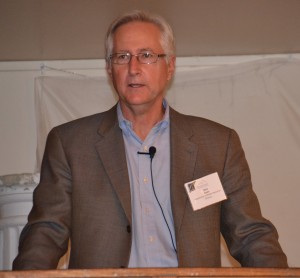 Mark Cowin-State Department of Water Resources
Mark Cowin-State Department of Water Resources
The Department of Water Resources (DWR) is responsible for managing and protecting California’s water, including operating the California State Water Project. DWR forecasts future water needs, inventories and evaluates existing water supplies, explores conservation and storage options, and supervises flood options, including emergency response to floods. It also administers more than $5 billion in bond funding for flood protection and ecosystem restoration.
Cowin, a civil engineer, has worked at DWR since 1981. He became director when Gov. Brown appointed him in 2010.
He focused his remarks on the Bay Delta Conservation Plan (BDCP). The proposed BDCP is a 50-year plan under the California Natural Resources Agency. A major component of the BDCP is upgrading the part of the State Water Project and related system improvements that are in the Delta. DWR has ultimate authority and responsibility to manage the design and construction of any new water facilities.
The other major component is a dual comprehensive ecosystem modification plan. Under state law, a Natural Community Conservation Plan will be under the California Department of Fish and Wildlife. The federal counterpart, a Habitat Conservation Plan, will be under joint authority of the U.S. Fish and Wildlife Service and the National Marine Fisheries Service.
In general, the water agencies that contract for water from the state and federal projects are expected to pay for the costs of conveyance, and the cost of habitat restoration will be paid statewide.
The plan and its accompanying Environmental Impact Report/Environmental Impact Statement are in the public comment stage, which will end July 29.
Cowin made an appeal to judge the plan for what it is. It is intended to protect endangered species in the Delta under the Endangered Species Act and stabilize deliveries. He said: If we don’t do anything and the fish populations continue to decline, we will have increasing regulations, continuing litigation and more stressors. Let’s get past the circular arguments.
He said that the BDCP provides innovative and efficient features. Elements of the plan change how water flows through the Delta. We will be able to reverse the reverse flows in the south that suck the fish into the pumps. New intakes in the north Delta will have state-of-the-art fish screens. It does involve tunnels. The amount of water exported will be tied to the populations of fish, he said.
Cowin said the BDCP will have a positive effect on the economic stability of the state. He pointed out the plan does not give a free pass to exporters. A 50-year permit does not trump the Endangered Species Act or water rights.
Especially in the Central Valley, groundwater is pumped to supplement surface water. In normal years, groundwater supplies about one-third of the total. In drought years, it averages 60 percent. “This is not sustainable,” he said. “We are not trying to stop people from using groundwater. We want to provide sustainable management by empowering local agencies to develop the tools, resources and standards with the State Water Resources Control Board as backstop.” Government needs to make an investment. We all need to put our shoulders into a combined effort, he said.
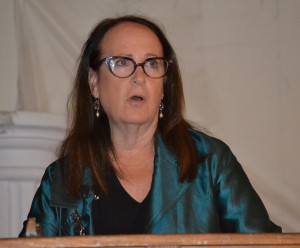 Felicia Marcus-State Water Resources Control Board
Felicia Marcus-State Water Resources Control Board
The State Water Resources Control Board (SWRCB) was created by the Legislature in 1967 with authority to allocate the waters of the state to achieve the optimum balance of beneficial uses and ensure the highest quality.
Chair Felicia Marcus, a lawyer, was appointed to the SWRCB by Gov. Jerry Brown in May 2012. At the time, she was serving on the Delta Stewardship Council, where Gov. Arnold Schwarzenegger appointed her in July 2010. Her previous career stages include: Los Angeles Board of Public Works commissioner, U.S. Environmental Protection Agency, Region 9 administrator, and western director for the Natural Resources Defense Council.
Marcus said there is a paradigm shift in water management: “It is more intelligent and integrated.” She gave as an example the Integrated Water Resources Management Program, in which water agencies coordinate planning and management of projects. She said she believes in the wisdom of locals, and that more money needs to be invested in the upper watersheds.
She said that the state and federal agencies have their place. Her job on the SWRCB is to balance all beneficiaries. “No one gets it all,” she said. We can’t continue with the rhetoric– “Is so. Is not. You’re a jerk. No, I’m not.” She said she respects action, getting things done.
We are experiencing less snowmelt and more flooding. Storage is not a “yes or no” issue. All types of storage need to be considered, and water rights need to be respected.
Marcus said the SWRCB is a water rights hearing board. The board has had to impose emergency curtailments on holders of junior water rights. A curtailment is an order to stop diverting water. She said it is a harsh system, but it is essential for public health and safety. Under the California Constitution, holders of water rights do not own the water. Their rights are usufructuary, or the right to use it. Holders of senior water rights have to use their water beneficially and not waste it, or they will lose their rights.
She would like to see voluntary compliance with the curtailments. Enforcements are unwieldy and time-intensive. But there will be some increased enforcement. “Otherwise, the board is just a paper tiger,” she said.
Marcus cited three approaches to augmenting water supply in the state: recycling, conservation and stormwater. She said southern California has a “great opportunity” to increase local water supplies by re-using stormwater, and decrease reliance on imported water.
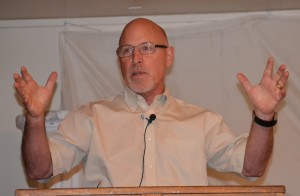 Randy Fiorini-Delta Stewardship Council
Randy Fiorini-Delta Stewardship Council
The Delta Stewardship Council (DSC) is an independent state agency. It was created by the Legislature in 2009 to develop a comprehensive long-term management plan for the Delta. Randy Fiorini said he has been fulltime as chair only since March. (The other six members are one-third time.) He finds it “an oddity to be a farmer from Turlock chairing a state agency dealing with the Delta.” He was raised on his family’s fruit tree and wine grape farm in Turlock, and continues in the family business. He is a past president of the Turlock Irrigation District and past president of the Association of California Water Agencies.
Fiorini was appointed to the Delta Stewardship Council by Gov. Arnold Schwarzenegger as one of the original members. Fiorini was elected vice chair at the first meeting of the DSC in April 2010.
His view is that regulations are not the answer to problems. He said the DSC is light on regulations and heavy on coordination.
“Who should care about what we do?” he posed. “In the third year of drought, we have significant unreliable water supply problems in the Delta.” On May 13, 2013, the DSC approved a Delta Plan that includes 12 regulations and 73 recommendations. If the BDCP is approved by the State Department of Fish and Wildlife, it will be incorporated into the Delta Plan.
The Delta Plan includes a Science Plan. Policy and science work together, he said. We use the best available science in dealing with the ecosystem. All the agencies are overloaded with data. We synthesize the information and provide a central location for all agencies to access and coordinate.
The ecosystem priorities in the Delta Plan are levee integrity, habitat restoration, instream and through-Delta flows, and predation. He said that 20-25 percent of current agricultural land will be converted to shallow water habitat.
He added that watershed management is important. “Many small projects have statewide importance.”
Fiorini said the Delta Plan aligns with the California Water Action Plan, a statewide integrated water management plan ordered by Gov. Brown and released in January. Fiorini explained: We want to move California to a more sustainable position.
He remarked that the drought has created an unprecedented level of cooperation, and he is optimistic that it will continue.
Fiorini likened the role of the DSC to that of professional basketball player John Stockton, point guard for the Utah Jazz. Stockton consistently led the league in the number of assists.
Panel Program
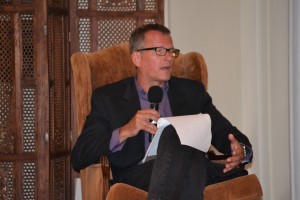
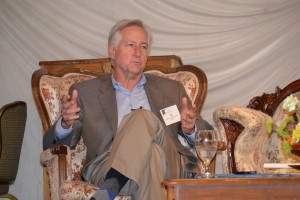

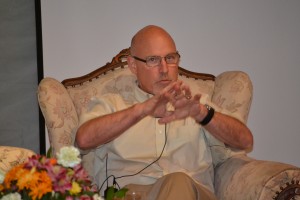

 Moderator Tom Philp introduced the panel discussion by saying that in 1986, Folsom Dam nearly overtopped, putting the Sacramento Valley in flood danger. Today, we have a different type of emergency crisis brought about by a prolonged and widespread drought.
Moderator Tom Philp introduced the panel discussion by saying that in 1986, Folsom Dam nearly overtopped, putting the Sacramento Valley in flood danger. Today, we have a different type of emergency crisis brought about by a prolonged and widespread drought.
Cowin said DWR had made important decisions in a short time. “We listened carefully,” he said.
Marcus said the SWRCB has had lots of meetings. “We are not done yet. Stakeholders on all sides are disappointed.” She said that some advocates take extreme positions to look good to the crowd vs. helping make decisions.”
She said that crises can bring people together. She mentioned the Sacramento Valley rice farmers who, although they have senior water rights, proposed smaller crop yields and agreed to take their water later.
Fiorini stated the Delta Plan goes to the end of the century. We will apply lessons learned, he said, referring to an adaptive management approach.
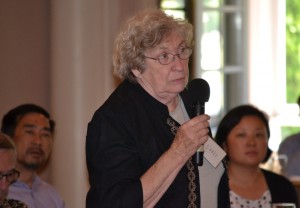 Nancy Weber, Nevada Irrigation District board member, said, “We lost structure. We don’t know how much we can depend on. You might take our carryover water.”
Nancy Weber, Nevada Irrigation District board member, said, “We lost structure. We don’t know how much we can depend on. You might take our carryover water.”
Marcus responded, “It shouldn’t be taken away. Our job is to protect water rights.”
Fiorini commented on the result of climate change. “California is not set up to deal with this,” he said. “We need regional interconnections.” He said water transfers should be reasonably priced and referred to an emergency transfer of 2,400 acre-feet from South San Joaquin Irrigation District to Tuolumne Utilities District at less than market value.
Philps said discussions in southern California are not focused on junior vs. senior water rights, but on what is the right mix of water system investments.
He mentioned a statewide poll conducted by USC Dornsife/Los Angeles Times in May and June that said the drought has had little or no impact on their daily lives. Cowin responded that there is a growing interest in a bond for increasing investment and in water in general. The investments would be consistent with the California State Water Action Plan.
Fiorini chimed in, saying that the public needs to be informed of the importance of investments in water. The majority of investments will be by locals, 85 percent. Ten percent will be by the state. He added, “The 1960s were the heyday of construction in California.” That was when the State Water Project was built. California spent 20 percent of state GDP on infrastructure. Now it is two percent.
Marcus commented that water quality always polls well.
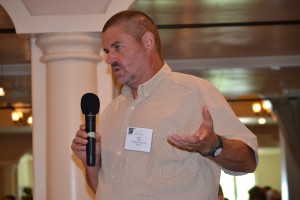 Norm Krizl, Georgetown Divide Public Utility District board member and Vice President of the Mountain Counties board, questioned the application of the co-equal goals in the BDCP. “Increase water supply reliability is left off the BDCP map,” he said.
Norm Krizl, Georgetown Divide Public Utility District board member and Vice President of the Mountain Counties board, questioned the application of the co-equal goals in the BDCP. “Increase water supply reliability is left off the BDCP map,” he said.
Cowin replied that the BDCP and California Water Action Plan have to work together. “It’s an all-of-the above strategy,” he said, and called for investment in the Integrated Regional Water Management Program.
Marcus pointed out, “The California Water Action Plan needs fleshing out for upper watersheds.”
Fiorini stated that during the Delta Plan process, Mountain Counties were active participants and advocates for area-of-origin water rights. “They are not disconnected from the Delta,” he said. “Delta operations have an effect on watersheds. It’s in all of our best interests to improve conditions in the Delta.”
Marcus said. “Fish talk is usually 75 percent flows. It’s not just flows.” We need a multiple-stressor approach that includes food, predation and habitat.
Karl Rodefer, Tuolumne County supervisor, introduced himself as coming from the home of the Rim Fire. He pointed out that 80 percent of the water supply comes from public lands.
Marcus replied that the U.S. Forest Service and Bureau of Land Management are starting to have conversations. She mentioned that illegal marijuana grows on public lands are becoming a water problem.
Cowin said the California Water Action Plan key agencies are meeting every six months to discuss implementation. The next meeting will be in November.
Bob Dean, ACWA Region 3 board chair and Calaveras County Water District board member, said that water in California comes from the Delta watershed and Colorado River. “We can’t resolve problems unless we understand where water originates.” He asked, “Why can’t the co-equal goals be applied everywhere?”
Marcus replied, “Yes, they apply to all.”
Cowin added, “Sustainable water management encompasses both, not one or the other.”
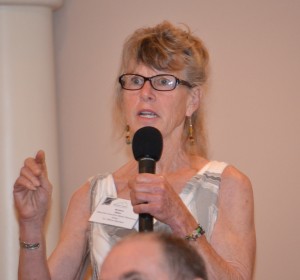 Barbara Balen, Mountain Counties ex officio board member and former Tuolumne Utilities District board member, asked about the integration of human and natural systems management.
Barbara Balen, Mountain Counties ex officio board member and former Tuolumne Utilities District board member, asked about the integration of human and natural systems management.
Marcus cited a program in Los Angeles created by a nonprofit called the TreePeople that plants trees to create urban forests.
Philp commented that Metropolitan is selling rain barrels. “They are going like hotcakes for outdoor water needs,” he said.
Mark Rentz, Integrated Natural Resources Management, suggested looking beyond the “litany of resources” to encompass biomass and forests. The values of integrated management include fiscal benefits, he said.
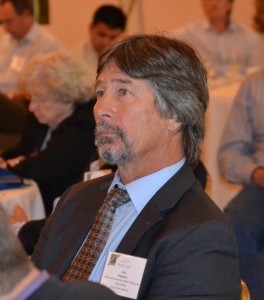 Mountain Counties Executive Director John Kingsbury inquired about the BDCP process.
Mountain Counties Executive Director John Kingsbury inquired about the BDCP process.
“At the end of the day, it is a permit process,” said Cowin. There is an extensive comment period going to the end of July. The plan is 40,000 pages. It is in its eighth year. Decisions will be made on imperfect information. We are seeking a 50-year plan.
Fiorini said the Delta Plan has six high-priority areas. It is “silent on conveyance.” The Delta Stewardship Council commented on the BDCP as a responsible agency. If it is permitted, it will be adopted into the Delta Plan. If not, there will be an appellate review of narrow issues. “Current conditions in the Delta are unsustainable,” he pointed out.
Marcus said it is important that the BDCP be included in the Delta Plan in order for it to be eligible for state funding, “as opposed to being up for grabs.”
She said the BDCP will need to meet flow standards and have a new point of diversion. “The southernmost diversion is the worst place.”
 Mountain Counties President Don Stump said, “We believe in all types of storage.”
Mountain Counties President Don Stump said, “We believe in all types of storage.”
Fiorini concurred, “There is no silver bullet.”
Cowin commented, “Nothing will happen without local champions who can demonstrate state interest and provide cost-sharing. He referred to the proposed 1.8 million acre-feet Sites Reservoir west of the Sacramento River that resulted from the formation of a joint powers authority. He also mentioned the Diamond Valley Reservoir near Hemet, where an archeological site was uncovered. The issue was resolved by the creation of a museum.
Fiorini concluded the panel discussion with a reference to the proposed installation of two radial arm gates that would add 3,000 acre-feet to Sugar Pine Reservoir in the Foresthill Public Utility District. It’s an “icon of opportunity with statewide benefits,” he said.
The program was co-sponsored by ECORP Consulting, Inc. and Sierra Nevada Conservancy, ATKINS. El Dorado County Water Agency was host.
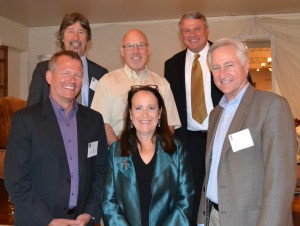
Lower Left: Tom Philp, Felicia Marcus, Mark Cowin
Top Left: John Kingsbury, Randy Fiorini, Don Stump
